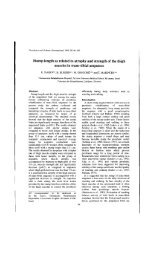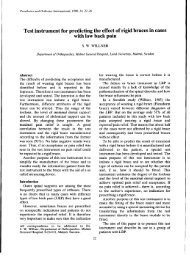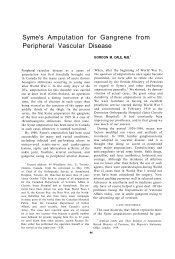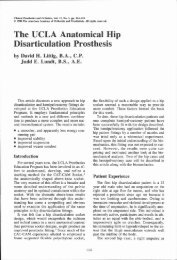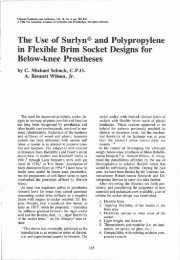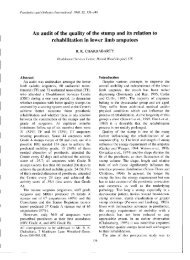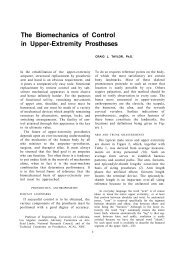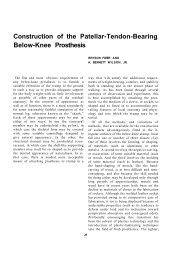Pro-Corn - O&P Library
Pro-Corn - O&P Library
Pro-Corn - O&P Library
You also want an ePaper? Increase the reach of your titles
YUMPU automatically turns print PDFs into web optimized ePapers that Google loves.
shop to speed the construction process.<br />
All pieces of Plastazote® are cut from large<br />
sheets into the rectangular sizes listed above.<br />
The cotton webbing and Velcro® are purchased<br />
on large rolls and cut to the sizes above in advance.<br />
A 1 1/2" x 2 1/2" patch of hook Velcro® is<br />
sewn to one end of a 1 1/2" x 9" piece of webbing.<br />
Approximately 1/2" of cotton webbing is<br />
left exposed on the very end so the end can be<br />
grasped by the patient to release the strap. A<br />
1 1/2" x 2 1/2" piece of pile Velcro® is sewn to<br />
the end of a 1 1/2" x 81/2" piece of webbing.<br />
This procedure is repeated on the 1" x 8 1/2"<br />
and 1" x 9" pieces of cotton webbing.<br />
The oven should be preheated to a temperature<br />
of 140° Celsius (285° Fahrenheit). This is<br />
the temperature at which all polyethylene materials<br />
should be heated.<br />
Plastazote® is a closed-cell polyethylene<br />
foam material. If polyethylene foam materials<br />
are overheated, the cell structure is weakened<br />
and the material shrinks in all directions. To<br />
determine the amount of time a polyethylene<br />
foam should be heated, measure the thickness<br />
of the material in millimeters and multiply the<br />
thickness by twelve (10 mm x 12 = 120<br />
seconds). The answer will be the time of<br />
heating in seconds.<br />
To mold the Plastazote® directly on the foot,<br />
the heated Plastazote® is placed between the<br />
foot and a thick foam rubber block. The foot is<br />
pressed into the foam and Plastazote®. The<br />
foam presses the polyethylene foam up around<br />
the sides of the foot and into every plantar<br />
hollow and the material cools and remains in<br />
this shape.<br />
The top/front of the foam a block is cut at a<br />
45° angle to prevent obtaining a deep mold of<br />
the toes (Figure 1). A deep mold would create a<br />
ridge distal to the ends of the toes. During gait,<br />
the medial foot enlongates with pronation. This<br />
elongation could result in distal toe damage on<br />
an insensitive foot if this ridge were present.<br />
Construction of the Sandal<br />
Patients are seated in an adjustable chair to<br />
insure the knee and ankle can be maintained at<br />
right angles as the Plastazote® is molded to<br />
their foot. Patients with insensitive feet are<br />
Figure 1. The open-celled foam block used to<br />
mold the Plastazote® footbed is cut on the top/<br />
front to prevent deep-molding the toes into the<br />
Plastazote®.<br />
Figure 2. As the first Plastazote® layer is cooling,<br />
a line is drawn to mark the outer edge of the<br />
sandal.<br />
asked to wear socks for heat insulation from the<br />
warm polyethylene foam.<br />
To begin the sandal, a piece of 6" x 12" x<br />
1/2" thick, medium, Plastazote® #1 is heated<br />
according to the above formula. After the Plastazote®<br />
has been heated, it is placed on the<br />
foam block with the toe region hanging over<br />
the 45° cut of the foam block. The foot is<br />
aligned over the Plastazote® with the metatarsal<br />
heads positioned over the top edge of the cutoff<br />
section of the foam block. The patient's<br />
foot is then pressed into the Plastazote®.<br />
After the Plastazote® foot bed has cooled,<br />
but before the patient is asked to lift their foot,<br />
an outline is drawn to mark a reference for what<br />
will become the outer sides of the sandal



